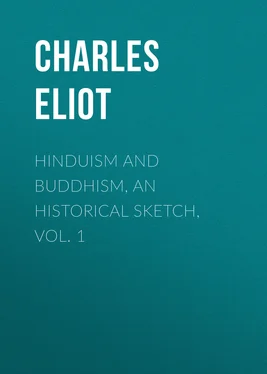Charles Eliot - Hinduism and Buddhism, An Historical Sketch, Vol. 1
Здесь есть возможность читать онлайн «Charles Eliot - Hinduism and Buddhism, An Historical Sketch, Vol. 1» — ознакомительный отрывок электронной книги совершенно бесплатно, а после прочтения отрывка купить полную версию. В некоторых случаях можно слушать аудио, скачать через торрент в формате fb2 и присутствует краткое содержание. Жанр: foreign_religion, Философия, Религиозная литература, foreign_psychology, foreign_antique, foreign_prose, на английском языке. Описание произведения, (предисловие) а так же отзывы посетителей доступны на портале библиотеки ЛибКат.
- Название:Hinduism and Buddhism, An Historical Sketch, Vol. 1
- Автор:
- Жанр:
- Год:неизвестен
- ISBN:нет данных
- Рейтинг книги:5 / 5. Голосов: 1
-
Избранное:Добавить в избранное
- Отзывы:
-
Ваша оценка:
- 100
- 1
- 2
- 3
- 4
- 5
Hinduism and Buddhism, An Historical Sketch, Vol. 1: краткое содержание, описание и аннотация
Предлагаем к чтению аннотацию, описание, краткое содержание или предисловие (зависит от того, что написал сам автор книги «Hinduism and Buddhism, An Historical Sketch, Vol. 1»). Если вы не нашли необходимую информацию о книге — напишите в комментариях, мы постараемся отыскать её.
Hinduism and Buddhism, An Historical Sketch, Vol. 1 — читать онлайн ознакомительный отрывок
Ниже представлен текст книги, разбитый по страницам. Система сохранения места последней прочитанной страницы, позволяет с удобством читать онлайн бесплатно книгу «Hinduism and Buddhism, An Historical Sketch, Vol. 1», без необходимости каждый раз заново искать на чём Вы остановились. Поставьте закладку, и сможете в любой момент перейти на страницу, на которой закончили чтение.
Интервал:
Закладка:
Alexander's invasion produced little direct effect, and no allusion to it has been found in Indian literature. But indirectly it had a great influence on the political, artistic and religious development of the Hindus by preparing the way for a series of later invasions from the north which brought with them a mixed culture containing Hellenic, Persian and other elements. During some centuries India, as a political region, was not delimitated on the north-western side as it is at present and numerous principalities rose and fell which included Indian territory as well as parts of Afghanistan.
These states were of at least three classes, Hellenistic, Persian or Parthian, and Scythian, if that word can be properly used to include the Sakas and Kushans.
Bactria was a Persian satrapy before Alexander's invasion but when he passed through it on his way to India he founded twelve cities and settled a considerable number of his soldiers in them. It formed part of the Empire of Seleucus but declared itself independent in 250 B.C. about the same time that the Parthians revolted and founded the Empire of the Arsacidae. The Bactrian kings bore Greek names and in 209 Antiochus III made peace with one of them called Euthydemus, in common cause against the nomads who threatened Western Asia. Demetrius, the son of this Euthydemus, appears to have conquered Kabul, the Panjab and Sind (c. 190 B.C.) but his reign was troubled by the rebellion of a certain Eukratides and it is probable that many small and contending frontier-states, of which we have a confused record, were ruled by the relatives of one or other of these two princes. The most important of them was Menander, apparently king of the Kabul valley. About 155 he made an incursion to the east, occupied Muttra and threatened Pataliputra itself but was repulsed. He is celebrated in Buddhist literature as the hero of the Questions of Milinda but his coins, though showing some Buddhist emblems, indicate that he was also a worshipper of Pallas. Shortly after this Hellenic influence in Bactria was overwhelmed by the invasion of the Yüeh-chih, though the Greek principalities in the Panjab may have lasted considerably longer.
In the reign of Mithridates (c. 171-138 B.C.) the Parthian Empire was limitrophe with India and possibly his authority extended beyond the Indus. A little later the Parthian dependencies included two satrapies, Aracosia and the western Panjab with capitals at Kandahar and Taxila respectively. In the latter ruled kings or viceroys one of whom called Gondophores (c. 20 A.D.) is celebrated on account of his legendary connection with the Apostle Thomas.
More important for the history of India were the conquests of the Sakas and Yüeh-chih, nomad tribes of Central Asia similar to the modern Turkomans 115 115 1But perhaps not in language. Recent research makes it probable that the Kushans or Yüeh-chih used an Iranian idiom.
. The former are first heard of in the basin of the river Ili, and being dislodged by the advance of the Yüeh-chih moved southwards reaching northwestern India about 150 B.C. Here they founded many small principalities, the rulers of which appear to have admitted the suzerainty of the Parthians for some time and to have borne the title of satraps. It is clear that western India was parcelled out among foreign princes called Sakas, Yavanas, or Pallavas whose frontiers and mutual relations were constantly changing. The most important of these principalities was known as the Great Satrapy which included Surashṭra (Kathiawar) with adjacent parts of the mainland and lasted until about 395 A.D.
The Yüeh-chih started westwards from the frontiers of China about 100 B.C. and, driving the Sakas before them, settled in Bactria. Here Kadphises, the chief of one of their tribes, called the Kushans, succeeded in imposing his authority on the others who coalesced into one nation henceforth known by the tribal name. The chronology of the Kushan Empire is one of the vexed questions of Indian history and the dates given below are stated positively only because there is no space for adequate discussion and are given with some scepticism, that is desire for more knowledge founded on facts. Kadphises I (c. 15-45 A.D.) after consolidating his Empire led his armies southwards, conquering Kabul and perhaps Kashmir. His successor Kadphises II (c. 45-78 A.D.) annexed the whole of north-western India, including northern Sind, the Panjab and perhaps Benares. There was a considerable trade between India and the Roman Empire at this period and an embassy was sent to Trajan, apparently by Kanishka (c. 78-123), the successor of Kadphises. This monarch played a part in the later history of Buddhism comparable with that of Asoka in earlier ages 116 116 1Fleet and Franke consider that Kanishka preceded the two Kadphises and began to reign about 58 B.C.
. He waged war with the Parthians and Chinese, and his Empire which had its capital at Peshawar included Afghanistan, Bactria, Kashgar, Yarkand, Khotan 117 117 1He appears to have been defeated in these regions by the Chinese general Pan-Chao about 90 A.D. but to have been more successful about fifteen years later.
and Kashmir. These dominions, which perhaps extended as far as Gaya in the east, were retained by his successors Huvishka (123-?140 A.D.) and Vasudeva (?140-178 A.D.), but after this period the Andhra and Kushan dynasties both collapsed as Indian powers, although Kushan kings continued to rule in Kabul. The reasons of their fall are unknown but may be connected with the rise of the Sassanids in Persia. For more than a century the political history of India is a blank and little can be said except that the kingdom of Surashṭra continued to exist under a Saka dynasty.
Light returns with the rise of the Gupta dynasty, which roughly marks the beginning of modern Hinduism and of a reaction against Buddhism. Though nothing is known of the fortunes of Pataliputra, the ancient imperial city of the Mauryas, during the first three centuries of our era, it continued to exist. In 320 a local Raja known as Candragupta I increased his dominions and celebrated his coronation by the institution of the Gupta era. His son Samudra Gupta continued his conquests and in the course of an extraordinary campaign, concluded about 340 A.D., appears to have received the submission of almost the whole peninsula. He made no attempt to retain all this territory but his effective authority was exercised in a wide district extending from the Hugli to the rivers Jumna and Chambal in the west and from the Himalayas to the Narbudda. His son Candragupta II or Vikramâditya added to these possessions Malwa, Gujarat and Kathiawar and for more than half a century the Guptas ruled undisturbed over nearly all northern India except Rajputana and Sind. Their capital was at first Pataliputra, but afterwards Kausambi and Ayodhya became royal residences.
The fall of the Guptas was brought about by another invasion of barbarians known as Hûnas, Ephthalites 118 118 1Or Hephthalites. The original name seems to have been something like Haptal.
or White Huns and apparently a branch of the Huns who invaded Europe. This branch remained behind in Asia and occupied northern Persia. They invaded India first in 455, and were repulsed, but returned about 490 in greater force and overthrew the Guptas. Their kings Toramâṇa and Mihiragula were masters of northern India till 540 and had their local capital at Sialkot in the Panjab, though their headquarters were rather in Bamyin and Balkh. The cruelties of Mihiragula provoked a coalition of Hindu princes. The Huns were driven to the north and about 565 A.D. their destruction was completed by the allied forces of the Persians and Turks. Though they founded no permanent states their invasion was important, for many of them together with kindred tribes such as the Gurjaras (Gujars) remained behind when their political power broke up and, like the Sakas and Kushans before them, contributed to form the population of north-western India, especially the Rajput clans.
Интервал:
Закладка:
Похожие книги на «Hinduism and Buddhism, An Historical Sketch, Vol. 1»
Представляем Вашему вниманию похожие книги на «Hinduism and Buddhism, An Historical Sketch, Vol. 1» списком для выбора. Мы отобрали схожую по названию и смыслу литературу в надежде предоставить читателям больше вариантов отыскать новые, интересные, ещё непрочитанные произведения.
Обсуждение, отзывы о книге «Hinduism and Buddhism, An Historical Sketch, Vol. 1» и просто собственные мнения читателей. Оставьте ваши комментарии, напишите, что Вы думаете о произведении, его смысле или главных героях. Укажите что конкретно понравилось, а что нет, и почему Вы так считаете.












